Applicability Analysis of Vegetation Condition and Dryness for Sand and Dust Storm (SDS) Risk Reduction in SDS Source and Receptor Region
Abstract
1. Introduction
2. Materials and Methods
2.1. Study Area
2.2. Data
2.2.1. SDS Meteorological Dataset
2.2.2. AVHRR GIMMS NDVI3g
2.2.3. Aridity Index
2.3. Data Processing and Analysis
2.3.1. Meteorological Dataset Preprocessing
2.3.2. Statistical Analysis between Indicators
2.3.3. Spatial Analysis between Indicators
3. Results
3.1. Statistical Analysis between SDS, NDVI, and AI
3.2. Identifying the Phased SDS Impact on the NDVI and AI
3.3. Identifying Regional Differences according to the NDVI and AI Pattern
4. Discussion
5. Conclusions
Author Contributions
Funding
Acknowledgments
Conflicts of Interest
References
- Moon, J.; Lee, W.K.; Song, C.; Lee, S.G.; Heo, S.B.; Shvidenko, A.; Kraxner, F.; Lamchin, M.E.; Lee, J.; Zhu, Y.; et al. An Introduction to Mid-Latitude Ecotone: Sustainability and environmental challenges. Sib. J. For. Sci. 2017, 6, 41–51. [Google Scholar] [CrossRef]
- Prospero, J.M.; Ginoux, P.; Torres, O.; Nicholson, S.E.; Gill, T.E. Environmental characterization of global sources of atmospheric soil dust identified with the Nimbus 7 Total Ozone Mapping Spectrometer (TOMS) absorbing aerosol product. Rev. Geophys. 2002, 40, 1002. [Google Scholar] [CrossRef]
- Middleton, N.; Kang, U. Sand and dust storms: Impact mitigation. Sustainability 2017, 9, 1053. [Google Scholar] [CrossRef]
- Song, C.; Pietsch, S.A.; Kim, M.; Cha, S.; Park, E.; Shvidenko, A.; Schepaschenko, D.; Kraxner, F.; Lee, W.-K. Assessing forest ecosystems across the vertical edge of the Mid-Latitude Ecotone using the BioGeoChemistry Management Model (BGC-MAN). Forests 2019, 10, 523. [Google Scholar] [CrossRef]
- Xu, J. Sand-dust storms in and around the Ordos Plateau of China as influenced by land use change and desertification. Catena 2006, 65, 279–284. [Google Scholar] [CrossRef]
- Ahmady-Birgani, H.; McQueen, K.G.; Moeinaddini, M.; Naseri, H. Sand dune encroachment and desertification processes of the rigboland Sand Sea, Central Iran. Sci. Rep. 2017, 7, 1523. [Google Scholar] [CrossRef]
- Cao, H.; Fu, C.; Zhang, W.; Liu, J. Characterizing sand and dust storms (SDS) intensity in China based on meteorological data. Sustainability 2018, 10, 2372. [Google Scholar] [CrossRef]
- Middleton, N.; Tozer, P.; Tozer, B. Sand and dust storms: Underrated natural hazards. Disasters 2019, 43, 390–409. [Google Scholar] [CrossRef]
- Goudie, A.S. Dust Storms and Human Health. In Extreme Weather Events and Human Health; Akhtar, R., Ed.; Springer: Cham, Switzerland, 2020. [Google Scholar] [CrossRef]
- UNEP; WMO; UNCCD. Global Assessment of Sand and Dust Storms, 1st ed.; United Nations Environment Programme: Nairobi, Kenya, 2016. [Google Scholar]
- Youlin, Y.; Squires, V.; Qi, L. Global Alarm: Dust and Sandstorms from the World’s Drylands; United Nations Convention to Combat Desertification (UNCCD): Bangkok, Thailand, 2002; Volume 345. [Google Scholar]
- Aili, A.; Oanh, N.T.K. Effects of dust storm on public health in desert fringe area: Case study of northeast edge of Taklimakan Desert, China. Atmos. Pollut. Res. 2015, 6, 805–814. [Google Scholar] [CrossRef]
- Jugder, D.; Shinoda, M.; Sugimoto, N.; Matsui, I.; Nishikawa, M.; Park, S.U.; Chun, Y.S.; Park, M.S. Spatial and temporal variations of dust concentrations in the Gobi Desert of Mongolia. Global Planet Chang. 2011, 78, 14–22. [Google Scholar] [CrossRef]
- Abdullaev, S.F.; Sokolik, I.N. Main Characteristics of Dust Storms and Their Radiative Impacts: With a Focus on Tajikistan. J. Atmos. Sci. 2019, 2, 2. [Google Scholar] [CrossRef]
- Goudie, A.S. Dust-storm source areas determined by the total ozone monitoring spectrometer and surface observations. Ann. Am. Assoc. Geogr. 2003, 93, 297–313. [Google Scholar] [CrossRef]
- Ginoux, P.; Prospero, J.M.; Gill, T.E.; Hsu, N.C.; Zhao, M. Global-scale attribution of anthropogenic and natural dust sources and their emission rates based on MODIS Deep Blue aerosol products. Rev. Geophys. 2012, 50. [Google Scholar] [CrossRef]
- Song, Z. A numerical simulation of dust storms in China. Environ. Model. Softw. 2014, 19, 141–151. [Google Scholar] [CrossRef]
- UNESCO. Map of the World Distribution of Arid Regions: Explanatory Note, 1st ed.; UNESCO: Paris, France, 1979; pp. 1–48. [Google Scholar]
- Tsolmon, R.; Ochirkhuyag, L.; Sternberg, T. Monitoring the source of trans-national dust storms in north east Asia. Int. J. Digit. Earth 2008, 1, 119–129. [Google Scholar] [CrossRef]
- Qu, J.; Hao, X.; Kafatos, M.; Wang, L. Asian dust storm monitoring combining Terra and Aqua MODIS SRB measurements. IEEE Geosci. Remote Sens. Lett. 2016, 3, 484–486. [Google Scholar] [CrossRef]
- Kazi, A.K.; Nagatani, I.; Kawano, K.; Kudoh, J.I. Development of a new dust index NDLI for Asian dust extraction system based on Aqua MODIS data and monitoring of trans-boundary Asian dust events in Japan. Int. J. Remote Sens. 2019, 40, 1030–1047. [Google Scholar] [CrossRef]
- Nagatani, I.; Kudoh, J.-I. Monitoring result of 2013 and 2014 transboundary Asian dust event in Japan using MODIS dust index. Int. J. Remote Sens. 2019, 40, 1030–1047. [Google Scholar] [CrossRef]
- Samadi, M.; Boloorani, A.D.; Alavipanah, S.K.; Mohamadi, H.; Najafi, M.S. Global dust Detection Index (GDDI); A new remotely sensed methodology for dust storms detection. J. Environ. Health Sci. Eng. 2014, 12, 20. [Google Scholar] [CrossRef]
- An, L.; Che, H.; Xue, M.; Zhang, T.; Wang, H.; Wang, Y.; Zhou, C.; Zhao, H.; Gui, K.; Zheng, Y.; et al. Temporal and spatial variations in sand and dust storm events in East Asia from 2007 to 2016: Relationships with surface conditions and climate change. Sci. Total Environ. 2018, 633, 452–462. [Google Scholar] [CrossRef]
- Kang, L.; Huang, J.; Chen, S.; Wang, X. Long-term trends of dust events over Tibetan Plateau during 1961–2010. Atmos. Environ. 2016, 125, 188–198. [Google Scholar] [CrossRef]
- Wang, X.; Dong, Z.; Zhang, J.; Liu, L. Modern dust storms in China: An overview. J. Arid Environ. 2014, 58, 559–574. [Google Scholar] [CrossRef]
- Sun, J.; Zhang, M.; Liu, T. Spatial and temporal characteristics of dust storms in China and its surrounding regions, 1960–1999: Relations to source area and climate. J. Geophys. Res. Atmos. 2001, 106, 10325–10333. [Google Scholar] [CrossRef]
- Xu, X.; Levy, J.K.; Zhaohui, L.; Hong, C. An investigation of sand-dust storm events and land surface characteristics in China using NOAA NDVI data. Glob. Planet Chang. 2006, 52, 182–196. [Google Scholar] [CrossRef]
- Sofue, Y.; Hoshino, B.; Demura, Y.; Kai, K.; Baba, K.; Nduati, E.; Kondoh, A.; Sternberg, T. Satellite monitoring of vegetation response to precipitation and dust storm outbreaks in Gobi Desert regions. Land 2018, 7, 19. [Google Scholar] [CrossRef]
- Yang, Y.Q.; Hou, Q.; Zhou, C.H.; Liu, H.L.; Wang, Y.Q.; Niu, T. Sand/dust storm processes in Northeast Asia and associated large-scale circulations. Atmos. Chem. Phys. 2008, 8, 25–33. [Google Scholar] [CrossRef]
- Zhang, K.; Qu, J.; Zu, R.; Fang, H. Temporal variations of sandstorms in Minqin oasis during 1954–2000. Environ. Geol. 2005, 49, 332–338. [Google Scholar] [CrossRef]
- Wang, X.; Lu, C.; Fang, J.; Shen, Y. Implications for development of grain-for-green policy based on cropland suitability evaluation in desertification-affected north China. Land Use Policy 2007, 24, 417–424. [Google Scholar] [CrossRef]
- Wang, X.M.; Zhang, C.X.; Hasi, E.; Dong, Z.B. Has the Three Norths Forest Shelterbelt Program solved the desertification and dust storm problems in arid and semiarid China? J. Arid Environ. 2010, 74, 13–22. [Google Scholar] [CrossRef]
- Tan, M.; Li, X. Does the Green Great Wall effectively decrease dust storm intensity in China? A study based on NOAA NDVI and weather station data. Land Use Policy 2015, 43, 42–47. [Google Scholar] [CrossRef]
- Fan, B.; Guo, L.; Li, N.; Chen, J.; Lin, H.; Zhang, X.; Shen, M.; Rao, Y.; Wang, C.; Ma, L. Earlier vegetation green-up has reduced spring dust storms. Sci. Rep. 2014, 4, 6479. [Google Scholar] [CrossRef] [PubMed]
- Middleton, N. Rangeland management and climate hazards in drylands: Dust storms, desertification and the overgrazing debate. Nat. Hazards 2018, 92, 57–70. [Google Scholar] [CrossRef]
- Dickerson, P.W. A Caspian chronicle: Sea level fluctuations between 1982 and 1997. In Dynamic Earth Environments: Remote Sensing Observations from Shuttle-Mir Missions, 1st ed.; Lulla, K.P., Dessinov, L.V., Eds.; John Wiley: New York, NY, USA, 2000; pp. 145–148. [Google Scholar]
- Indoitu, R.; Orlovsky, L.; Orlovsky, N. Dust storms in Middle Asia: Spatial and temporal variations. WIT Trans. Ecol. Environ. 2009, 122, 353–364. [Google Scholar] [CrossRef]
- Indoitu, R.; Orlovsky, L.; Orlovsky, N. Dust storms in Central Asia: Spatial and temporal variations. J. Arid Environ. 2012, 85, 62–70. [Google Scholar] [CrossRef]
- Indoitu, R.; Kozhoridze, G.; Batyrbaeva, M.; Vitkovskaya, I.; Orlovsky, N.; Blumberg, D.; Orlovsky, L. Dust emission and environmental changes in the dried bottom of the Aral Sea. Aeolian Res. 2015, 17, 101–115. [Google Scholar] [CrossRef]
- Issanova, G.; Abuduwaili, J. Dust storms in Central Asia and Kazakhstan: Regional division, frequency and seasonal distribution. In Aeolian Processes as Dust Storms in the Deserts of Central Asia and Kazakhstan; Springer: Singapore, 2017; pp. 87–109. [Google Scholar]
- Löw, F.; Navratil, P.; Kotte, K.; Schöler, H.F.; Bubenzer, O. Remote-sensing-based analysis of landscape change in the desiccated seabed of the Aral Sea–A potential tool for assessing the hazard degree of dust and salt storms. Environ. Monit. Assess. 2013, 185, 8303–8319. [Google Scholar] [CrossRef]
- Micklin, P.; Aladin, N.V.; Plotnikov, I. The Aral Sea, 1st ed.; Springer: Berlin, Germany, 2014; pp. 1–11. [Google Scholar]
- Isamiddinova, D. Report on the Status of Women in Uzbekistan, 1st ed.; United Nations Development Programme: New York, NY, USA, 1999; pp. 1–80. [Google Scholar]
- Kim, J.; Song, C.; Lee, S.; Jo, H.-W.; Park, E.; Yu, H.; Cha, S.; An, J.; Son, Y.; Khamzina, A.; et al. Identifying Potential Vegetation Establishment Areas in the Aral Sea using Satellite Images. Land Degrad. Dev. 2020. [Google Scholar] [CrossRef]
- Lee, W.-K.; Kim, S.J.; Lee, S.J.; Park, E.; Kim, J.; Park, S.; Kim, G.; Kim, N.; Lee, W.; Shaimerdenova, A.; et al. Developing Geospatial and Statistical Indicators for DRR: A Pilot Study of Drought, Flood, Sand and Dust Storm, and Air Pollution in South Korea and Kazakhstan, 1st ed.; OJERI, eGISRS, IEE: Seoul, Korea, 2019; pp. 1–73. [Google Scholar]
- Xi, X.; Sokolik, I.N. Dust interannual variability and trend in Central Asia from 2000 to 2014 and their climatic linkages. J. Geophys. Res. Atmos. 2015, 120, 12–175. [Google Scholar] [CrossRef]
- Zhou, C.; Gui, H.; Hu, J.; Ke, H.; Wang, Y.; Zhang, X. Detection of new dust sources in Central/East Asia and their impact on simulations of a severe sand and dust storm. J. Geophys. Res. Atmos. 2019, 124, 10232–10247. [Google Scholar] [CrossRef]
- Liu, A.; Wang, J.; Liu, Z.; Wang, J. Monitoring desertification in arid and semi-arid areas of China with NOAA-AVHRR and MODIS data. In Proceedings of the 2005 IEEE International Geoscience and Remote Sensing Symposium, Seoul, Korea, 29 July 2005; Volume 4, pp. 2362–2364. [Google Scholar]
- Zolotokrylin, A.N. Dust storms in Turanian lowland. Proc. Russ. Acad. Sci. Geogr. Ser. 1996, 6, 48–54. [Google Scholar]
- Aitsi-Selmi, A.; Egawa, S.; Sasaki, H.; Wannous, C.; Murray, V. The Sendai framework for disaster risk reduction: Renewing the global commitment to people’s resilience, health, and well-being. Int. J. Disaster Risk Sci. 2015, 6, 164–176. [Google Scholar] [CrossRef]
- Guan, Q.; Sun, X.; Yang, J.; Pan, B.; Zhao, S.; Wang, L. Dust storms in northern China: Long-term spatiotemporal characteristics and climate controls. J. Clim. 2017, 30, 6683–6700. [Google Scholar] [CrossRef]
- Orlovsky, L.; Orlovsky, N.; Durdyev, A. Dust storms in Turkmenistan. J. Arid Environ. 2005, 60, 83–97. [Google Scholar] [CrossRef]
- Met Office. MIDAS: Global Weather Observation Data. In NCAS British Atmospheric Data Centre; 2006. Available online: https://catalogue.ceda.ac.uk/uuid/0ec59f09b3158829a059fe70b17de951 (accessed on 20 May 2020).
- Xu, X.; Chen, H. Influence of vegetations and snow cover on sand-dust events in the west of China. Chin. Sci. Bull. 2006, 51, 331–340. [Google Scholar] [CrossRef]
- Anyamba, A.; Tucker, C.J. Analysis of Sahelian vegetation dynamics using NOAA-AVHRR NDVI data from 1981–2003. J. Arid Environ. 2005, 63, 596–614. [Google Scholar] [CrossRef]
- Funk, C.C.; Brown, M.E. Intra-seasonal NDVI change projections in semi-arid Africa. Remote Sens. Environ. 2006, 101, 249–256. [Google Scholar] [CrossRef]
- Holm, A.M.R.; Cridland, S.W.; Roderick, M.L. The use of time-integrated NOAA NDVI data and rainfall to assess landscape degradation in the arid shrubland of Western Australia. Remote Sens. Environ. 2003, 85, 145–158. [Google Scholar] [CrossRef]
- Tabari, H.; Aghajanloo, M.B. Temporal pattern of aridity index in Iran with considering precipitation and evapotranspiration trends. Int. J. Clim. 2013, 33, 396–409. [Google Scholar] [CrossRef]
- de Martonne, E. Aréisme et Indice d’aridité. Comptes Rendus Acad. Sci. 1926, 2, 1395–1398. [Google Scholar]
- Thornthwaite, C.W. An approach toward a rational classification of climate. J. Nucl. Mater. 1948, 66, 55–94. [Google Scholar] [CrossRef]
- O’Loingsigh, T.; McTainsh, G.H.; Tews, E.K.; Strong, C.L.; Leys, J.F.; Shinkfield, P.; Tapper, N.J. The Dust Storm Index (DSI): A method for monitoring broadscale wind erosion using meteorological records. Aeolian Res. 2014, 12, 29–40. [Google Scholar] [CrossRef]
- Cao, H.; Liu, J.; Wang, G.; Yang, G.; Luo, L. Identification of sand and dust storm source areas in Iran. J. Arid Land 2015, 7, 567–578. [Google Scholar] [CrossRef]
- WMO. WMO code 4677 Present weather symbols. In Manual on Codes; WMO: Bremerhaven, Germany, 2011; p. 357. [Google Scholar]
- Aili, A.; Oanh, N.T.K.; Abuduwaili, J. Variation Trends of Dust Storms in Relation to Meteorological Conditions and Anthropogenic Impacts in the Northeast Edge of the Taklimakan Desert, China. Open J. Air Pollut. 2016, 5, 127–143. [Google Scholar] [CrossRef]
- Wang, Y.Q.; Zhang, X.Y.; Gong, S.L.; Zhou, C.H.; Hu, X.Q.; Liu, H.L.; Niu, T.; Yang, Y.Q. Surface observation of sand and dust storm in East Asia and its application in CUACE/Dust. Atmos. Chem. Phys. 2008, 8, 545–553. [Google Scholar] [CrossRef]
- Breckle, S.-W. Aralkum: A Man-Made Desert: The Desiccated Floor of the Aral Sea (Central Asia), 1st ed.; Springer: Berlin, Germany, 2012; pp. 1–488. [Google Scholar]
- Issanova, G.; Abuduwaili, J.; Kaldybayev, A.; Semenov, O.; Dedova, T. Dust storms in Kazakhstan: Frequency and division. J. Geol. Soc. India 2015, 85, 348–358. [Google Scholar] [CrossRef]
- Shao, Y.; Dong, C.H. A review on East Asian dust storm climate, modelling, and monitoring. Glob. Planet Chang 2006, 52, 1–22. [Google Scholar] [CrossRef]
- Tada, R.; Zheng, H.; Clift, P.D. Evolution and variability of the Asian monsoon and its potential linkage with uplift of the Himalaya and Tibetan Plateau. Prog. Earth Planet. Sci. 2016, 3, 4. [Google Scholar] [CrossRef]
- Saura, J.R.; Reyes-Menendez, A.; Palos-Sanchez, P. Mapping multispectral Digital Images using a Cloud Computing software: Applications from UAV images. Heliyon 2019, 5, e01277. [Google Scholar] [CrossRef]
- Palos-Sanchez, P.; Saura, J.R. The effect of internet searches on afforestation: The case of a green search engine. Forests 2018, 9, 51. [Google Scholar] [CrossRef]
- Yu, F.; Price, K.P.; Ellis, J.; Feddema, J.J.; Shi, P. Interannual variations of the grassland boundaries bordering the eastern edges of the Gobi Desert in central Asia. Int. J. Remote Sens. 2004, 25, 327–346. [Google Scholar] [CrossRef]
- Zhang, Z.; Huisingh, D. Combating desertification in China: Monitoring, control, management, and revegetation. J. Clean. Prod. 2018, 182, 765–775. [Google Scholar] [CrossRef]
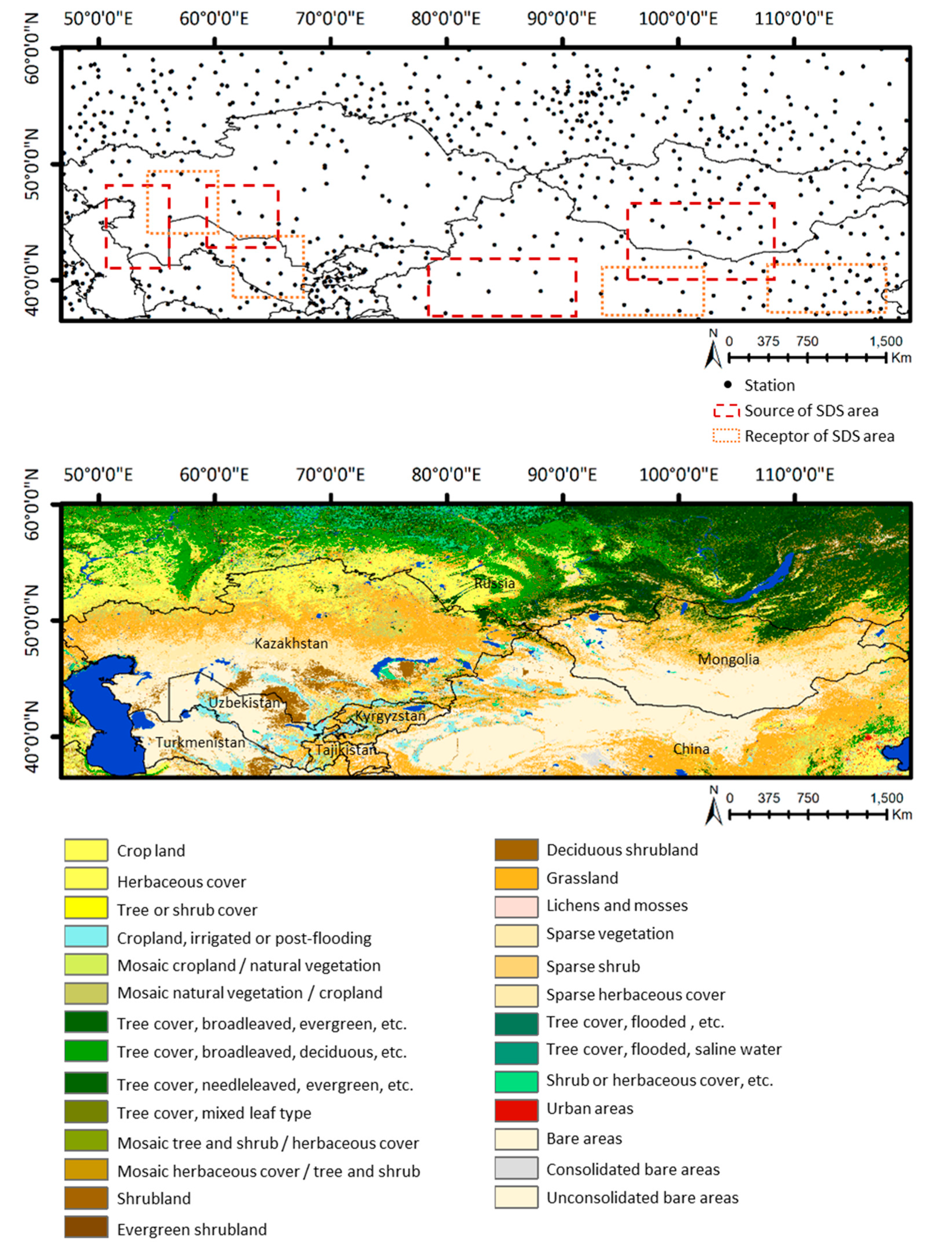
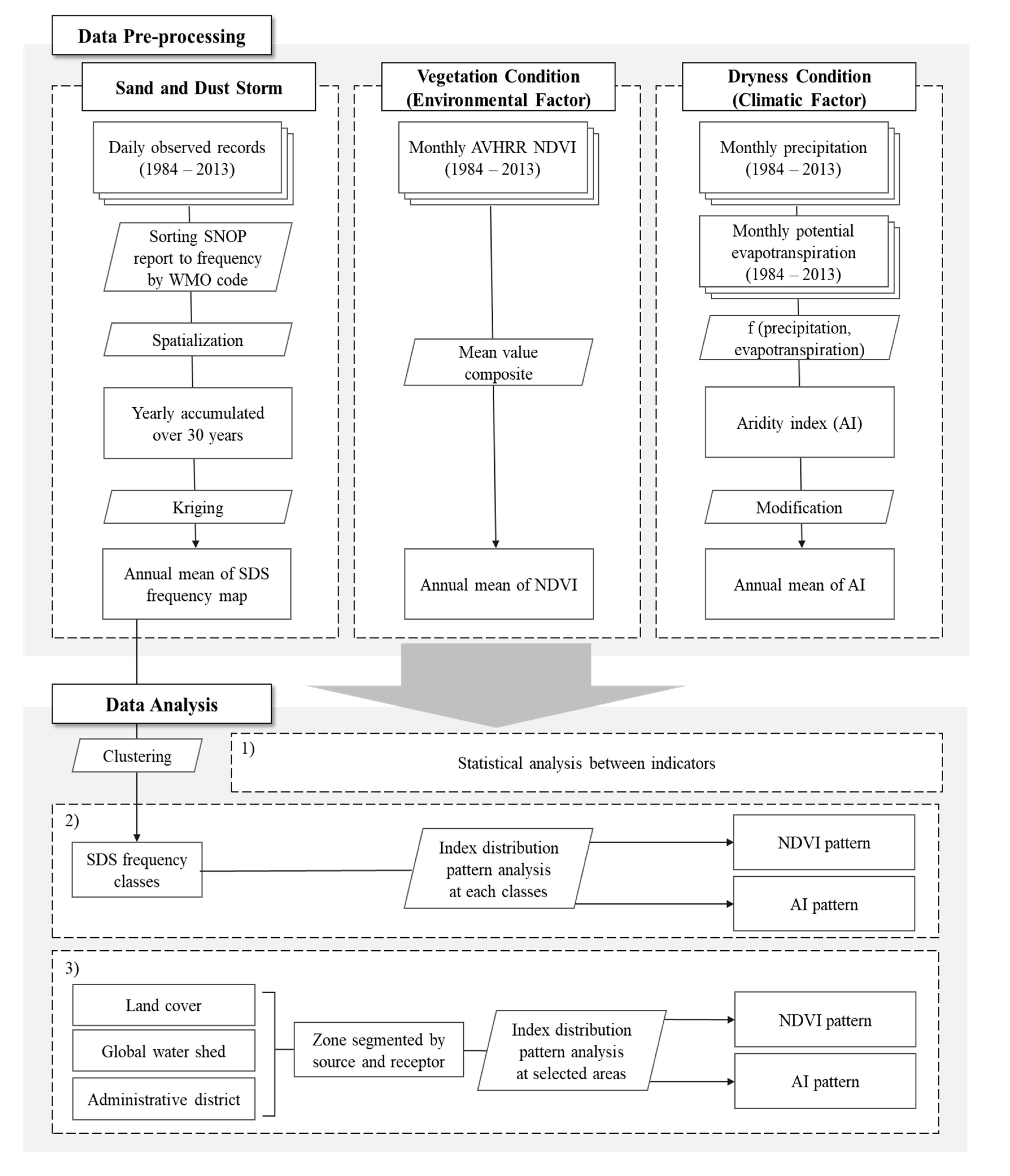
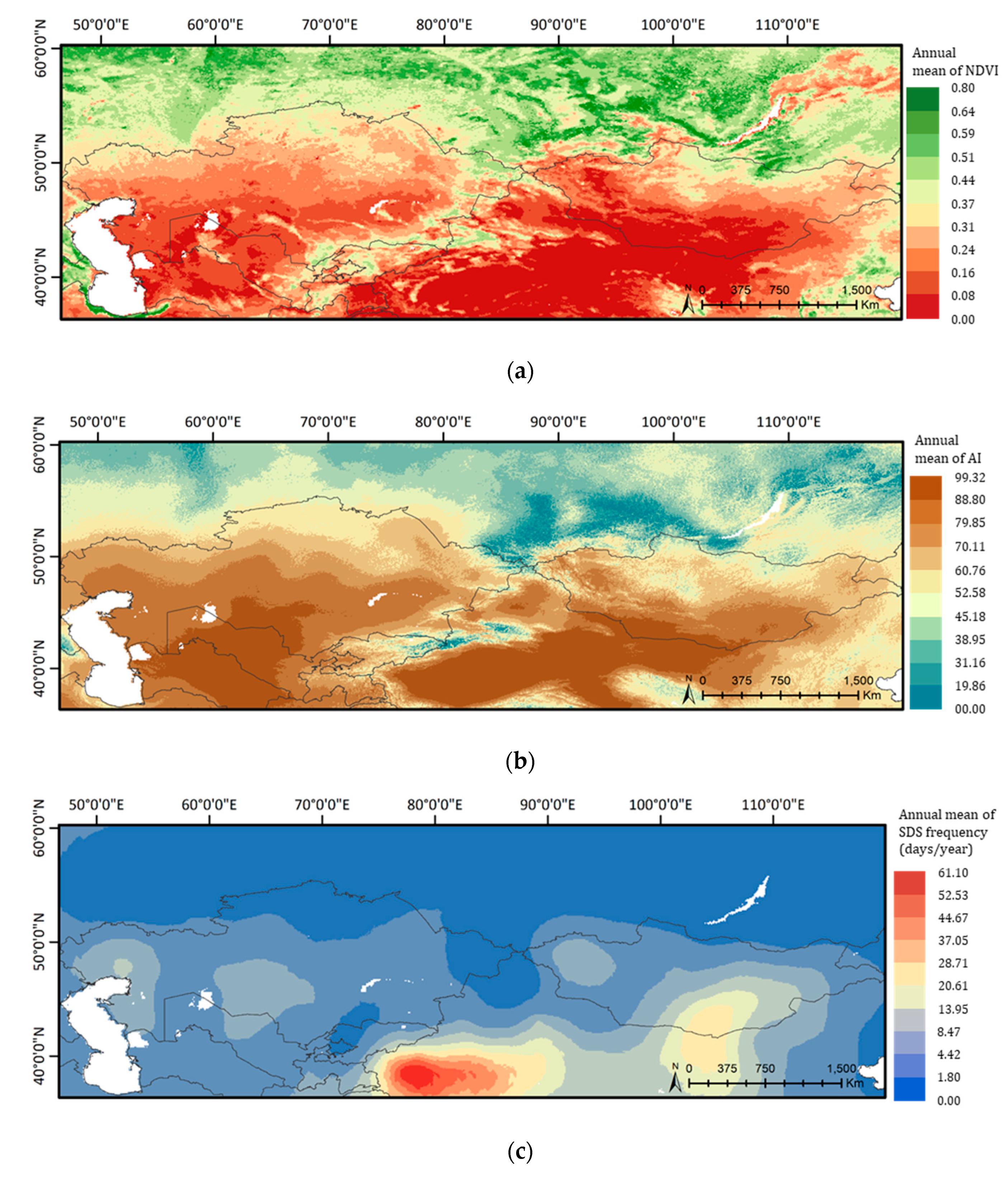
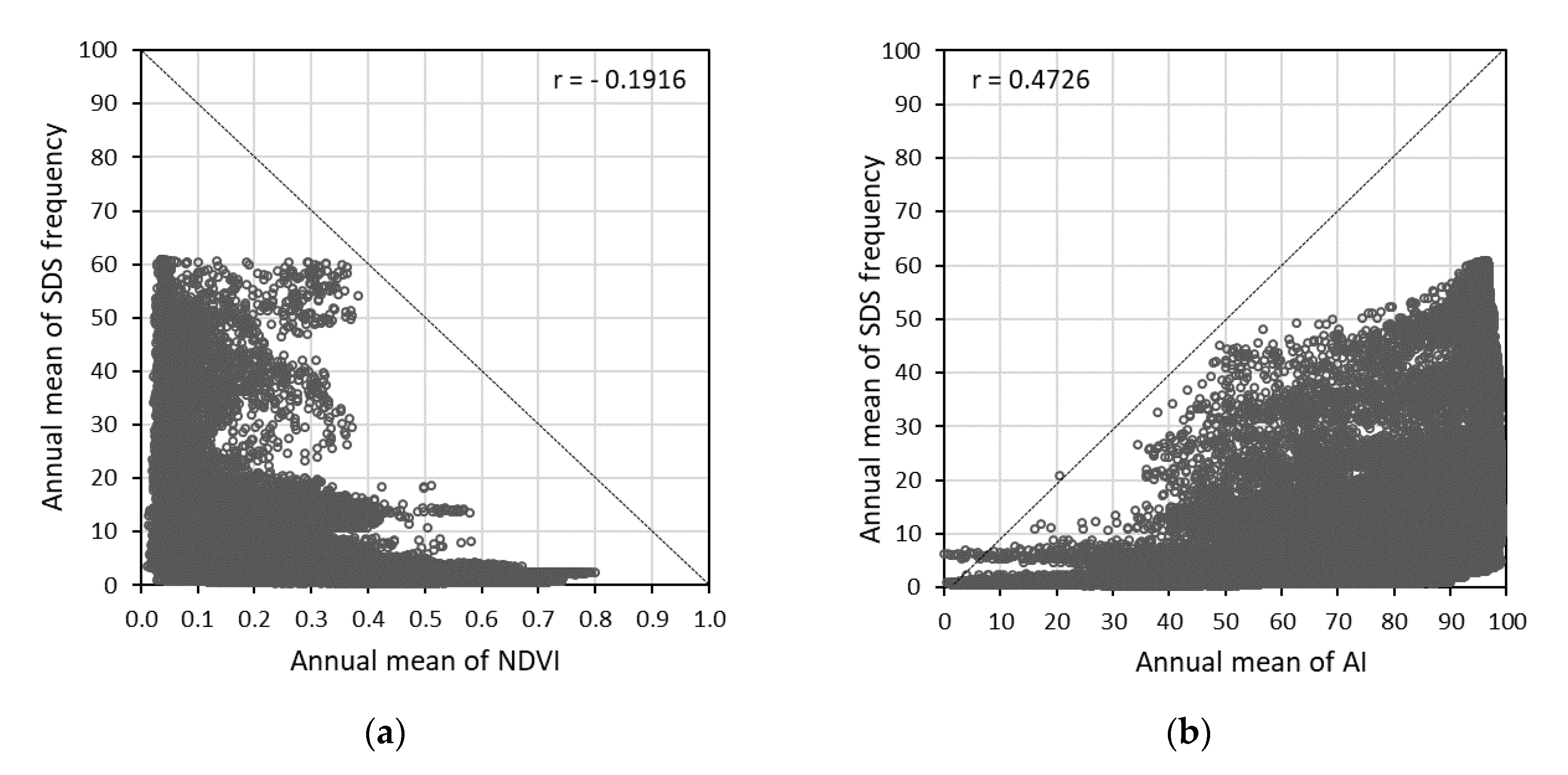

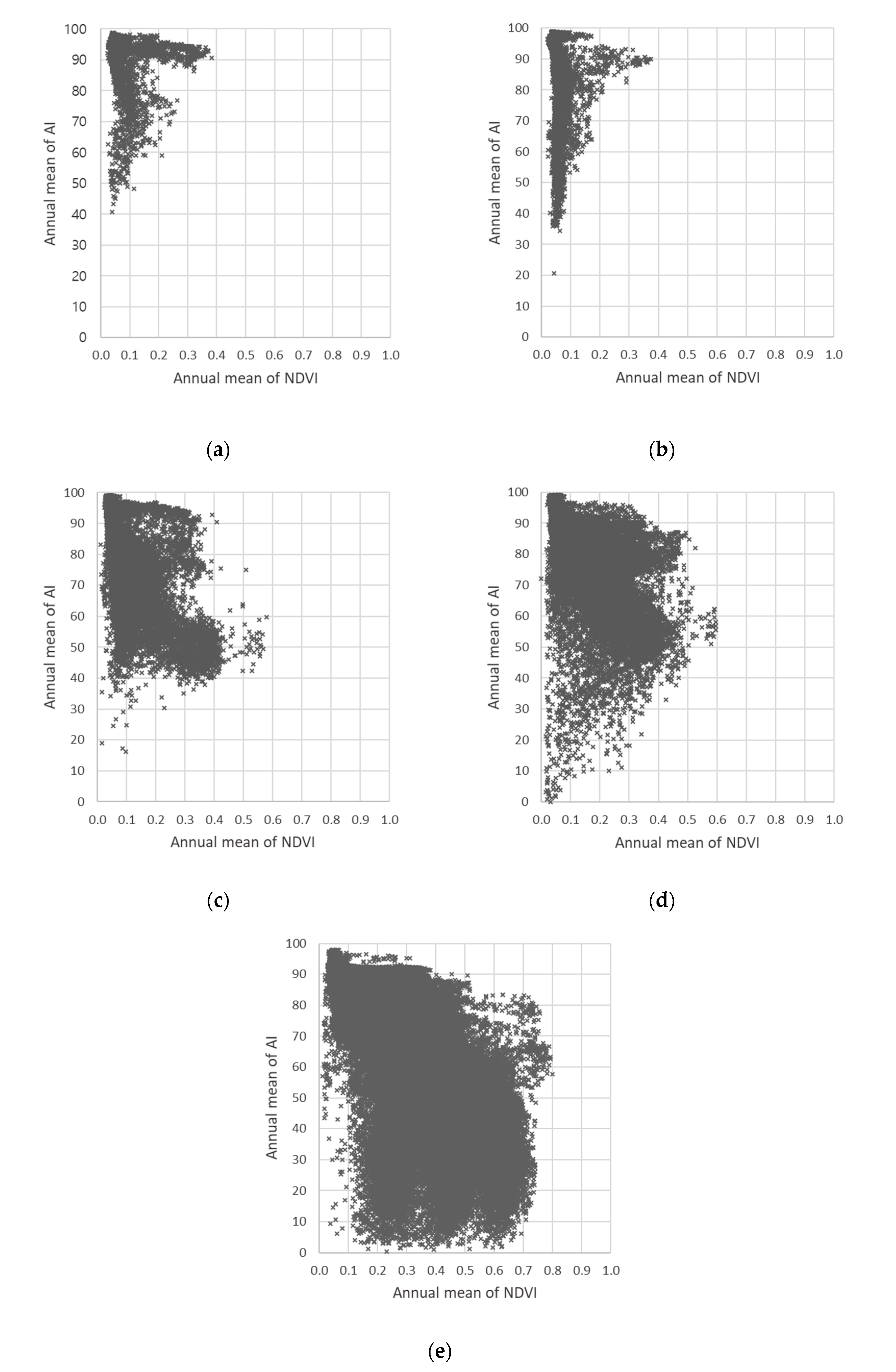
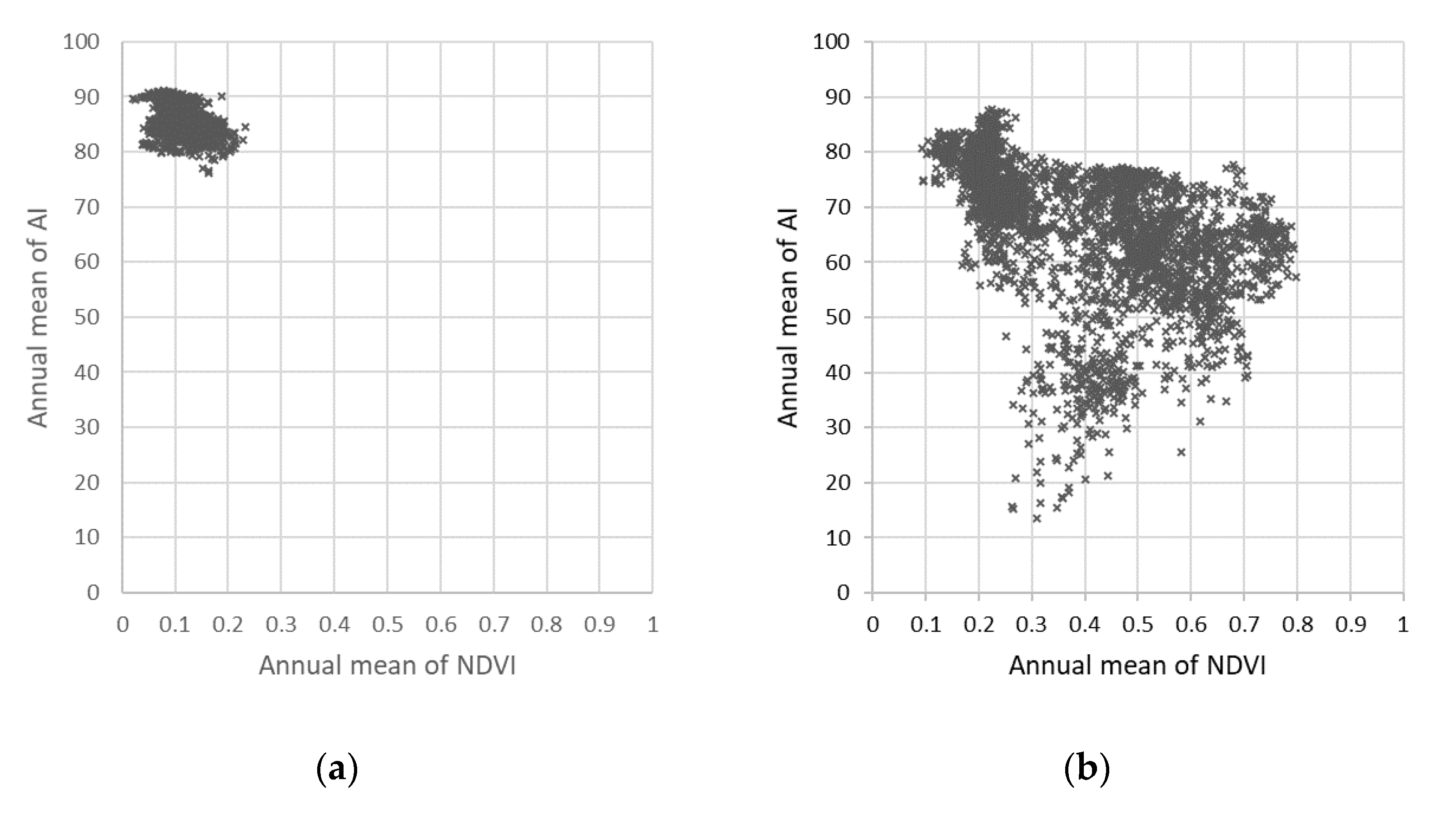
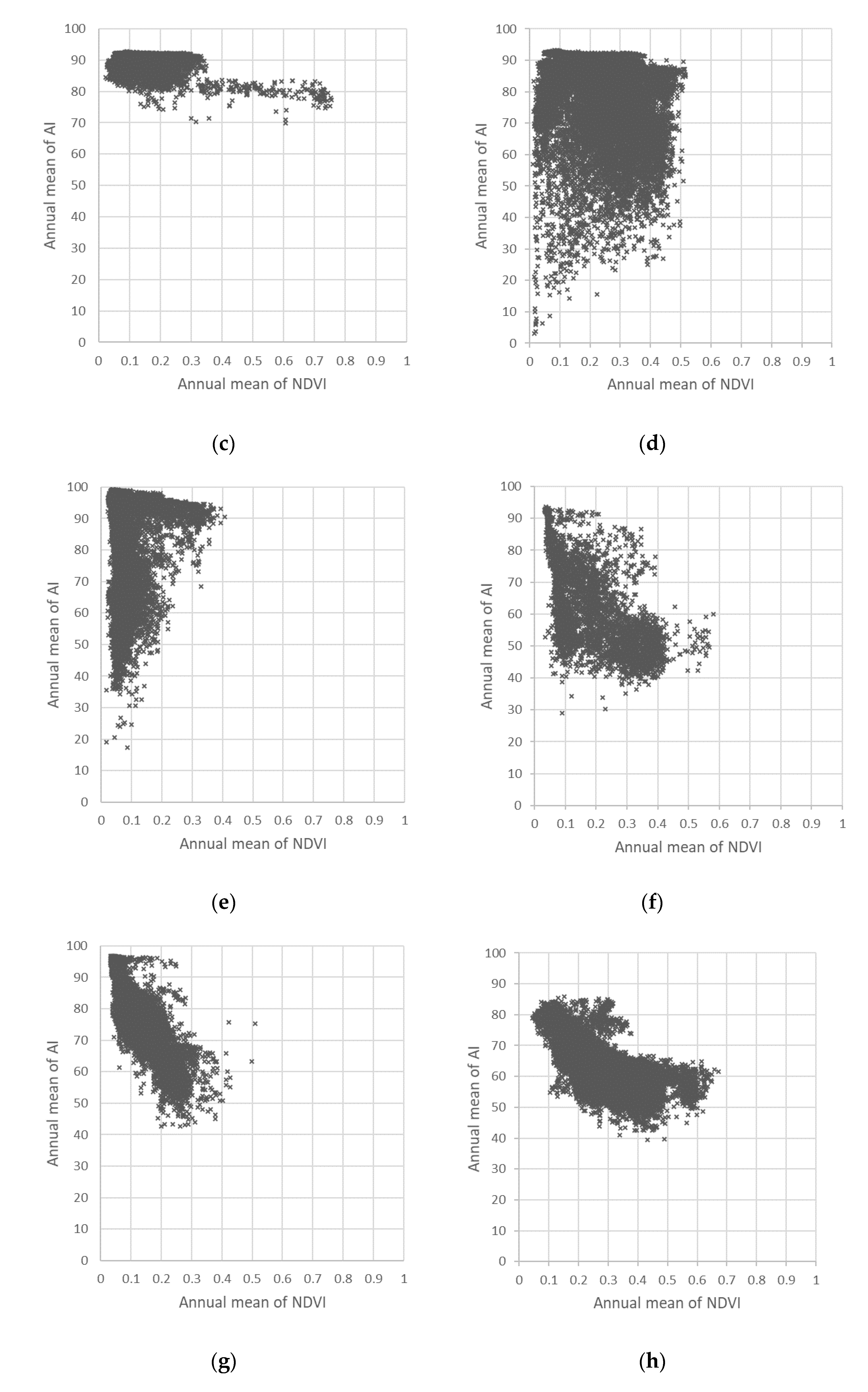
| Selected Area | Longitude | Latitude | |
|---|---|---|---|
| Caspian Sea in Central Asia | SDS source | 50.302–56.683 | 39.712–46.029 |
| SDS receptor | 55.618–60.935 | 44.778–50.157 | |
| Aral Sea in Central Asia | SDS source | 59.872–66.906 | 42.089–47.906 |
| SDS receptor | 63.75–70.693 | 36.772–42.401 | |
| Taklamakan Desert in East Asia | SDS source | 76.322–90.083 | 36.459–40.525 |
| SDS receptor | 92.022–98.027 | 36.647–40.15 | |
| Gobi Desert in East Asia | SDS source | 96.025–106.283 | 39.211–45.341 |
| SDS receptor | 108.598–118.355 | 36.897–40.275 | |
| SYNOP Code | Weather Description |
|---|---|
| 06 | Widespread dust in suspension in the air, not raised by wind at or near the station at the time of observation. |
| 07 | Dust or sand raised by wind at or near the station at the time of observation, but not well-developed dust whirl or sand whirl, and no dust storm or sandstorm seen; or, in the case of ships, blowing spray at the station. |
| 08 | Well-developed dust or sand whirl seen at or near the station during the preceding hour or at the time of observation, but no dust storm or sandstorm. |
| 09 | Dust storm or sandstorm within sight at the time of observation, or at the station during the preceding hour. |
| 30 | Slight or moderate dust storm or sandstorm—has decreased during the preceding hour. |
| 31 | Slight or moderate dust storm or sandstorm—no appreciable change during the preceding hour. |
| 32 | Slight or moderate dust storm or sandstorm—has begun or has increased during the preceding hour. |
| 33 | Severe dust storm or sandstorm—has decreased during the preceding hour. |
| 34 | Severe dust storm or sandstorm—no appreciable change during the receding hour. |
| 35 | Severe dust storm or sandstorm—has begun or has increased during the preceding hour. |
| 98 | Thunderstorm combined with dust/sandstorm at time of observation. |
| SDS | NDVI | AI | |
|---|---|---|---|
| SDS | 1 | ||
| NDVI | −0.1916 | 1 | |
| AI | 0.4726 | −0.3322 | 1 |
| Variable | Parameter Estimate | Standard Error | t Value | Pr > |t| |
|---|---|---|---|---|
| Intercept | −5.6072 | 0.0495 | −113.27 | <0001 |
| AI | 0.1679 | 0.0006 | 240.63 | <0001 |
| NDVI | −0.6566 | 0.0322 | −20.37 | <0001 |
© 2020 by the authors. Licensee MDPI, Basel, Switzerland. This article is an open access article distributed under the terms and conditions of the Creative Commons Attribution (CC BY) license (http://creativecommons.org/licenses/by/4.0/).
Share and Cite
Park, E.; Kim, J.; Song, C.; Jo, H.-W.; Lee, S.; Kim, S.J.; Park, S.; Lim, C.-H.; Lee, W.-K. Applicability Analysis of Vegetation Condition and Dryness for Sand and Dust Storm (SDS) Risk Reduction in SDS Source and Receptor Region. Sustainability 2020, 12, 7256. https://doi.org/10.3390/su12187256
Park E, Kim J, Song C, Jo H-W, Lee S, Kim SJ, Park S, Lim C-H, Lee W-K. Applicability Analysis of Vegetation Condition and Dryness for Sand and Dust Storm (SDS) Risk Reduction in SDS Source and Receptor Region. Sustainability. 2020; 12(18):7256. https://doi.org/10.3390/su12187256
Chicago/Turabian StylePark, Eunbeen, Jiwon Kim, Cholho Song, Hyun-Woo Jo, Sujong Lee, Sea Jin Kim, Sugyeong Park, Chul-Hee Lim, and Woo-Kyun Lee. 2020. "Applicability Analysis of Vegetation Condition and Dryness for Sand and Dust Storm (SDS) Risk Reduction in SDS Source and Receptor Region" Sustainability 12, no. 18: 7256. https://doi.org/10.3390/su12187256
APA StylePark, E., Kim, J., Song, C., Jo, H.-W., Lee, S., Kim, S. J., Park, S., Lim, C.-H., & Lee, W.-K. (2020). Applicability Analysis of Vegetation Condition and Dryness for Sand and Dust Storm (SDS) Risk Reduction in SDS Source and Receptor Region. Sustainability, 12(18), 7256. https://doi.org/10.3390/su12187256









